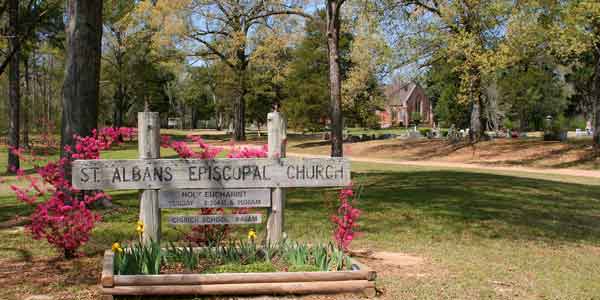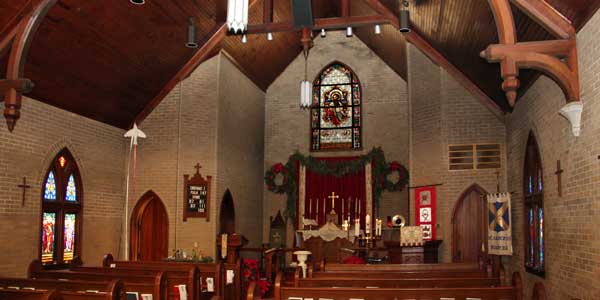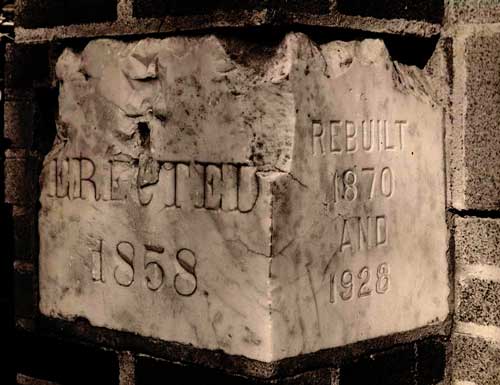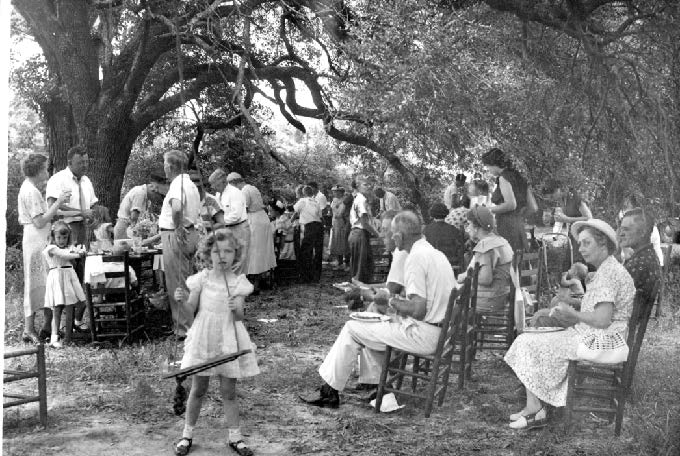
 St. Alban's Episcopal
St. Alban's Episcopal
Come to the County
Our church is located in a country setting in the tiny community of Bovina, Mississippi. We are seven miles east of Vicksburg. As your car turns off the paved road and onto the slag drive, you approach St. Alban's Church on a circular drive way that is surrounded by Live Oaks and Cedar Trees. The churchyard dates to pre-Civil War days. Spanish moss hangs from the limbs of the trees. A cemetery spills out across the lawn. Our country setting offers a serene atmosphere that is conductive to abiding in God's presence.

Our community practices holy hospitality. We rely on one of Saint Benedict's Rules of Life as our standard: "Let all who enter here be welcomed as Christ." We are a community that seeks to serve Christ in each other and everyone we encounter.

The interior of the church reflects the feel of the country with simple stained glass windows and an altar crafted from oak. A sense of the Holy permeates the landscape and the inscape.
The celebration of the Holy Eucharist on Sunday mornings and Wednesday evenings is the starting point to learn more about the Episcopal Church. Each Eucharist is includes Old and New Testament readings, prayers, the offering of peace to each other, and Holy Communion. The members of St. Alban's Church are nourished by our communal worship and our participation in the sacraments. We feast on the Bread of Life and the Cup Salvation each time we come together for the Holy Eucharist.

Our History
St. Alban's was first organized as a parish in 1857 when a group of cotton farmers along the Big Black River joined together in worship. Mrs. William Sthreshley invited the Rev. Henry Sanson of Canton, Mississippi, to perform a service in the Bovina community. The first service was held in the Baptist church at Mt. Alban, just west of Bovina in the fall of 1857. In response to a general request from those who attended for another service at the earliest possible time, the Reverend Sanson held a second service 4 - 6 weeks later. At the close of the service, on November 29, 1857, the Articles of Association were adopted by seventeen men and women of the area to form St. Alban's. A vestry was elected, and Henry Sanson, D.D., was asked to serve as Rector, supplying the parish with services once a month.
On June 18, 1858, the vestry and congregation voted to erect a church about a quarter mile southwest of the train depot in Bovina. Three and three-quarter acres of land near the tracks were deeded to the "Vestrymen and trustees of the Protestant Episcopal Church called the Church of the Nativity" by Mr. and Mrs. Peterson Bass on September 23, 1858, and $5,000 was raised to build the church. The Rt. Rev. William M. Green, Bishop of Mississippi, consecrated the church now known as St. Alban's on May 5, 1859. Rev. William C. Crane of Jackson gave the sermon on that day. The Bishop also confirmed 19 people, five of whom were slaves.

During the Civil War, the planters and their slaves continued regular worship at St. Alban's, with the number of slave communicants eventually outnumbering the white. In the summer of 1862, St. Alban's and the Bovina community became havens for the civilians who fled Vicksburg during its first bombardment. By May 1863, St. Alban's was "appropriated for military purposes," and rifle pits were dug all over the grounds during the siege of Vicksburg.
On July 4, 1863, Vicksburg surrendered to Grant. Traditional accounts state that the church was used as a butcher shop, a dance saloon, and a stable. One traditional report states that the cornerstone of the church was used for bayonet practice, but contemporary study suggests it was rather used for rifle target practice. Regardless of the how or why, St. Alban's lay in complete ruin after the occupation. All that remained was the mutilated cornerstone and a few pieces of glass from the windows which Mrs. Amelia Barr saved "for sentiments sake."
Seven years passed before steps to re-establish a parish were taken. Dr. William Barr asked the Rev. James Angel Fox, a long time member of the parish and a retired pastor, to serve as rector of St. Alban's. In his letter of acceptance, Parson Fox wrote, "We all wish to see the St. Alban's rise from its ashes and ruins & although we cannot expect to behold the comely edifice and flourishing congregation that existed previous to the horrid scenes of 1863, we may still hope, that with God's blessing, the St. Alban's may afford shelter and consolation to many in their journey to this 'vale of tears' to a better and more enduring inheritance."
Parson Fox began the building fund by seeking a donation from St. Alban's Church in New York. Ten years and $1,200 later, St. Alban's had a new church building, of plain plank, on the grounds of the original church. In one of the doors was a small window which incorporated the pieces of glass saved by Mrs. Barr. The new building was consecrated on February 27, 1880. The Rev. Fox died the next year.
The people of St. Alban's continued to worship in their small frame building until 1928. In that year the Rev. Sessions oversaw the building of the current beautiful brick chapel given by Townsend Palmer and his sister, Mrs. Nathan Fabrizio, in memory of their mother, Matilda Townsend Palmer. The family was descended from John and Samuel Townsend, signers of the Articles of Confederation of the church in 1857. The old frame church was remodeled into the present Parish Hall.
A new Sunday School structure with offices, classrooms and modern kitchen was added and dedicated "Sessions Hall" after a former rector, Van Sessions, on October 29, 1967 by Bishop Allin. A new rectory was built on land just east of the church and finished in October 1976. The dream of a pipe organ for St. Alban's materialized. A new tracker organ was dedicated, July 16, 1978.

St. Alban's has been famous through the years for its wonderful "Dinners-on-the-grounds," in October when the congregation and guests gather under the giant cedar and live oak trees for homemade dishes for a hungry. The ECW also offers homemade baked goods, breads, sweets, jams and jellies and crafts for sale.